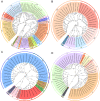Current status of hand-foot-and-mouth disease
- PMID: 36829162
- PMCID: PMC9951172
- DOI: 10.1186/s12929-023-00908-4
Current status of hand-foot-and-mouth disease
Abstract
Hand-foot-and-mouth disease (HFMD) is a viral illness commonly seen in young children under 5 years of age, characterized by typical manifestations such as oral herpes and rashes on the hands and feet. These symptoms typically resolve spontaneously within a few days without complications. Over the past two decades, our understanding of HFMD has greatly improved and it has received significant attention. A variety of research studies, including epidemiological, animal, and in vitro studies, suggest that the disease may be associated with potentially fatal neurological complications. These findings reveal clinical, epidemiological, pathological, and etiological characteristics that are quite different from initial understandings of the illness. It is important to note that HFMD has been linked to severe cardiopulmonary complications, as well as severe neurological sequelae that can be observed during follow-up. At present, there is no specific pharmaceutical intervention for HFMD. An inactivated Enterovirus A71 (EV-A71) vaccine that has been approved by the China Food and Drug Administration (CFDA) has been shown to provide a high level of protection against EV-A71-related HFMD. However, the simultaneous circulation of multiple pathogens and the evolution of the molecular epidemiology of infectious agents make interventions based solely on a single agent comparatively inadequate. Enteroviruses are highly contagious and have a predilection for the nervous system, particularly in child populations, which contributes to the ongoing outbreak. Given the substantial impact of HFMD around the world, this Review synthesizes the current knowledge of the virology, epidemiology, pathogenesis, therapy, sequelae, and vaccine development of HFMD to improve clinical practices and public health efforts.
Keywords: Epidemiological characteristic; Hand-foot-and-mouth disease; Innate immune response; Sequelae; Treatment.
© 2023. The Author(s).
Conflict of interest statement
The authors have declared that no competing interests exist.
Figures





References
Publication types
MeSH terms
Grants and funding
- NO. 82273695/National Natural Science Foundation of China
- NO. 82002147/National Natural Science Foundation of China
- NO. 82073618/National Natural Science Foundation of China
- NO. 2019M662543/China Postdoctoral Science Foundation
- NO. 21A310026/Key Scientific Research Project of Henan Institution of Higher Education
LinkOut - more resources
Full Text Sources
Miscellaneous

